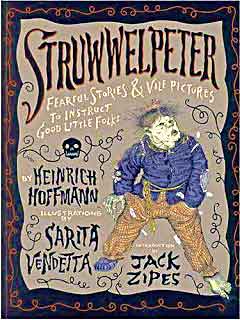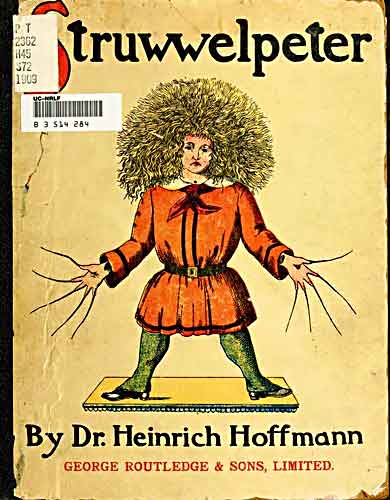 By HEINRICH HOFFMANN, SARITA VENDETTA, JACK ZIPES (Feral House; 1999)
By HEINRICH HOFFMANN, SARITA VENDETTA, JACK ZIPES (Feral House; 1999)
Originally published in Germany in 1845, STRUWWELPETER is a collection of rhymes describing various horrible misfortunes that befall misbehaving kids. Written by a respected German physician as a “gift” for his young son, it’s apparently the most enduring kids’ book of all time, and also one of the most sadistic and outrageous. Debate continues to rage about the nature of its contents, a debate amplified in this 1999 edition.
Published by the fringe outfit Feral House, the ‘99 edition of STRUWWELPETER contains a lengthy introduction by Jack Zipes, an authority on children’s literature who argues that the book was a harmless diversion taken overly seriously by 19th Century readers. Also included are two separate versions of STRUWWELPTER: the original English translation entitled “Slovenly Peter” and an updated version featuring extremely gruesome and macabre illustrations by the underground artist Sarita Vendetta, as well as “Struwwelhitler,” a piece of British WWII propaganda patterned on STRUWWELPETER.
 But of course what resonates most about this book is the depraved imagination of Heinrich Hoffmann, which after 170 years continues to startle. See “The Story of Romping Polly,” about a girl who loses a leg after disobeying her aunt’s warning to “be more steady”; “The Little Glutton,” who disregards her mother’s entreaty to stop overeating and as a result is attacked by a hive-full of bees; and “Jimmy Spiderlegs,” who loses all his arms and legs after sliding down a stairway banister a few too many times. The set-up in all cases is the same: a misbehaving child disobeys an adult’s instructions and meets a horrific fate.
But of course what resonates most about this book is the depraved imagination of Heinrich Hoffmann, which after 170 years continues to startle. See “The Story of Romping Polly,” about a girl who loses a leg after disobeying her aunt’s warning to “be more steady”; “The Little Glutton,” who disregards her mother’s entreaty to stop overeating and as a result is attacked by a hive-full of bees; and “Jimmy Spiderlegs,” who loses all his arms and legs after sliding down a stairway banister a few too many times. The set-up in all cases is the same: a misbehaving child disobeys an adult’s instructions and meets a horrific fate.
Those fates vary, of course, in severity and plausibility. Many are decidedly fantastic, and even downright surreal, such as the giant nose grafted onto the face of “Ned the Toy-Breaker,” the ever-stretching neck of “Phoebe Ann, the Proud Girl,” and the eyeballs of “The Crybaby,” which fall out of their sockets due to excessive crying. Then there are downright horrific entries like “The Story of Little Suck-A-Thumb,” whose thumbs are sliced off by a spectral Scissor Man, and “Cruel Paul,” who gets bitten to death by a pack of wild animals.
In his introduction Jack Zipes claims modern kid-skewering fictions like “Dennis the Menace,” CHARLIE THE CHOCOLATE FACTORY and the work of Edward Gorey were all directly inspired by STRUWWELPETER. Yet in their original and unadorned form, as presented here, these tales more than stand on their own in elegant simplicity and inventive nastiness.
